10 books about Late Middle Ages

Between Church and State
The Lives of Four French Prelates in the Late Middle Ages
Bernard Guenée
University of Chicago Press, 1990
For the past several decades, French historians have emphasized the writing of history in terms of structures, cultures, and mentalities, an approach exemplified by proponents of the Annales school. With this volume, Bernard Guenée, himself associated with the Annalistes, marks a decisive break with this dominant mode of French historiography. Still recognizing the Annalistes' indispensable contribution, Guenée turns to the genre of biography as a way to attend more closely to chance, to individual events and personalities, and to a sense of time as people actually experienced it. His erudite, lively, elegantly written study links in sequence the lives of four French bishops, illuminating medieval and early modern history through their writings.
Guenée chooses as his frame the momentous period from the height of Saint Louis's reign in the mid-thirteenth century to the beginning of the Italian wars two hundred years later. During this time of schism in the church, of war between nascent states, and of treachery among princes, Bernard Gui (1261-1331), Gilles Le Muisit (1272-1353), Pierre D'Ailly (1351-1420), and Thomas Basin (1412-1490) all rose from modest circumstances to the dignity of office. Guenée shows us how these prelates used their talent, ambition, patrons, zeal, and experience to juggle the competing demands of obedience to church and state; to overcome competition from an upcoming new generation; and to cope with plague, war, and violence. Free of jargon yet steeped in learning, Between Church and State reveals the career patterns and politics of an era while forging a new model for points of departure in historical scholarship.
Guenée chooses as his frame the momentous period from the height of Saint Louis's reign in the mid-thirteenth century to the beginning of the Italian wars two hundred years later. During this time of schism in the church, of war between nascent states, and of treachery among princes, Bernard Gui (1261-1331), Gilles Le Muisit (1272-1353), Pierre D'Ailly (1351-1420), and Thomas Basin (1412-1490) all rose from modest circumstances to the dignity of office. Guenée shows us how these prelates used their talent, ambition, patrons, zeal, and experience to juggle the competing demands of obedience to church and state; to overcome competition from an upcoming new generation; and to cope with plague, war, and violence. Free of jargon yet steeped in learning, Between Church and State reveals the career patterns and politics of an era while forging a new model for points of departure in historical scholarship.
[more]
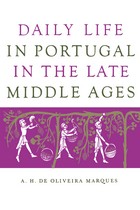
Daily Life in Portugal in the Late Middle Ages
A.H. de Oliviera Marques; Translated by S.S. Wyatt
University of Wisconsin Press, 1971
Past studies of medieval Portugal have focused on such specific themes as political or administrative history and voyages of discovery. Oliveira Marques, however, has captured the vast spectrum of Portuguese daily life from the twelfth through the fifteenth centuries The whole of medieval society is depicted, both on a national scale and, more important, society as it affected the individual in his everyday activities. Oliveira Marques gives us an engaging and original social history which examines customary meals, dress, homes, work, spiritual life, even ideas about courtship and love. Medieval Portuguese culture and education, amusements and funeral customs are all a part of this portrait.
[more]
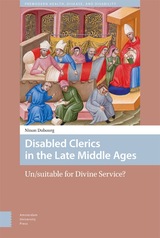
Disabled Clerics in the Late Middle Ages
Un/suitable for Divine Service?
Ninon Dubourg
Amsterdam University Press, 2023
The petitions received and the letters sent by the Papal Chancery during the Late Middle Ages attest to the recognition of disability at the highest levels of the medieval Church. These documents acknowledge the existence of physical and/or mental impairments, with the papacy issuing dispensations allowing some supplicants to adapt their clerical missions according to their abilities. A disease, impairment, or old age could prevent both secular and regular clerics from fulfilling the duties of their divine office. Such conditions can, thus, be understood as forms of disability. In these cases, the Papal Chancery bore the responsibility for determining if disabled people were suitable to serve as clerics, with all the rights and duties of divine services. Whilst some petitioners were allowed to enter the clergy, or – in the case of currently serving churchmen – to stay more or less active in their work, others were compelled to resign their position and leave the clergy entirely. Petitions and papal letters lie at intersection of authorized, institutional policy and practical sources chronicling the lived experiences of disabled people in the Middle Ages. As such, they constitute an excellent analytical laboratory in which to study medieval disability in its relation to the papacy as an institution, alongside the impact of official ecclesiastical judgments on disabled lives.
[more]
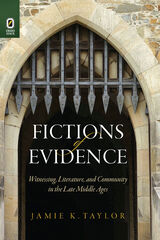
Fictions of Evidence
Witnessing, Literature, and Community in the Late Middle Ages
Jamie K. Taylor
The Ohio State University Press, 2013
Throughout the Middle Ages, witnessing was a crucial way religious and legal “truths” were understood and produced. Religious and secular officials alike harnessed the power of testimony to assert doctrinal, political, or legal responsibilities. Swearing an oath, testifying in court, and signing a deposition were common ways to shape and discipline both devotional and legal communities. In Fictions of Evidence: Witnessing, Literature, and Community in the Late Middle Ages, Jamie K. Taylor traces depictions of witnessing in a wide range of late medieval texts and shows how witnessing practices formed and reformed, policed and challenged medieval communities.
Through close study of texts like the Man of Law’s Tale and Piers Plowman alongside sermon exempla, common law statutes, and pastoral treatises, Fictions of Evidence argues that vernacular literature was a vital site of criticism and dissent. It shows that devotional and legal witnessing practices offered medieval writers a distinct vocabulary they could use to expose how the ethical and legal obligations to one’s community were constructed. And since vernacular writers often challenged the ways ecclesiastical or secular authorities asserted community bonds, they found they could use those same witnessing practices and language to imagine extra-legal or extra-ecclesiastical communities that followed different ethical codes.
[more]
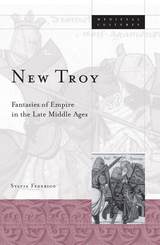
New Troy
Fantasies Of Empire In The Late Middle Ages
Sylvia Federico
University of Minnesota Press, 2003
Examines the political and literary uses of the Trojan legend in the medieval period.
England in the late fourteenth century witnessed a large-scale social revolt, a lingering and seemingly hopeless war with France, and fierce factional conflicts in royal politics and London civic government--struggles in which all parties sought to justify their actions by claiming historical precedent. How the Trojan legend figured in these claims--and in competing assertions of authorial legitimacy, nationhood, and rule in the later Middle Ages--is the complex nexus of history, myth, literature, and identity that Sylvia Federico explores in this ambitious book.
During the late medieval period, many European political and social groups took great pains to associate themselves with the ancient city; the claim on Troy, Federico asserts, was crucial to nationhood and was always a political act. Her book examines the poetry and prose of several late medieval authors, focusing particularly on how Chaucer's use of the Trojan legend helped to set the terms by which the Ricardian and Lancastrian periods were distinguished, and further helped to establish English literary history as a noble precedent in its own right. Federico's book affords remarkable insight into the workings of the medieval historical imagination.
Sylvia Federico has taught at Washington State University and the University of Leeds. She currently lives in Maine.
[more]
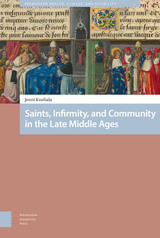
Saints, Infirmity, and Community in the Late Middle Ages
Jenni Kuuliala
Amsterdam University Press, 2020
Bodily suffering and patient, Christlike attitudes towards that suffering were among the key characteristics of sainthood throughout the medieval period. Drawing on new work in medieval dis/ability studies, this book analyses the meanings given to putative saints' bodily infirmities in late medieval canonization hearings. How was an individual saint's bodily ailment investigated in the inquests, and how did the witnesses (re)construct the saintly candidates' ailments? What meanings were given to infirmity when providing proofs for holiness? This study depicts holy infirmity as an aspect of sanctity that is largely defined within the community, in continual dialogue with devotees, people suffering from doubt, the holy person, and the cultural patterns ascribed to saintly life. Furthermore, it analyses how the meanings given to saints' infirmities influenced and reflected society's attitudes towards bodily ailments in general.
[more]
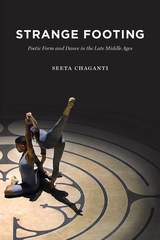
Strange Footing
Poetic Form and Dance in the Late Middle Ages
Seeta Chaganti
University of Chicago Press, 2018
For premodern audiences, poetic form did not exist solely as meter, stanzas, or rhyme scheme. Rather, the form of a poem emerged as an experience, one generated when an audience immersed in a culture of dance encountered a poetic text.
Exploring the complex relationship between medieval dance and medieval poetry, Strange Footing argues that the intersection of texts and dance produced an experience of poetic form based in disorientation, asymmetry, and even misstep. Medieval dance guided audiences to approach poetry not in terms of the body’s regular marking of time and space, but rather in the irregular and surprising forces of virtual motion around, ahead of, and behind the dancing body. Reading medieval poems through artworks, paintings, and sculptures depicting dance, Seeta Chaganti illuminates texts that have long eluded our full understanding, inviting us to inhabit their strange footings askew of conventional space and time.
Strange Footing deploys the motion of dance to change how we read medieval poetry, generating a new theory of poetic form for medieval studies and beyond.
Exploring the complex relationship between medieval dance and medieval poetry, Strange Footing argues that the intersection of texts and dance produced an experience of poetic form based in disorientation, asymmetry, and even misstep. Medieval dance guided audiences to approach poetry not in terms of the body’s regular marking of time and space, but rather in the irregular and surprising forces of virtual motion around, ahead of, and behind the dancing body. Reading medieval poems through artworks, paintings, and sculptures depicting dance, Seeta Chaganti illuminates texts that have long eluded our full understanding, inviting us to inhabit their strange footings askew of conventional space and time.
Strange Footing deploys the motion of dance to change how we read medieval poetry, generating a new theory of poetic form for medieval studies and beyond.
[more]
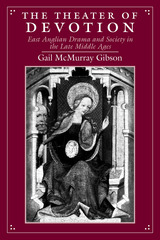
The Theater of Devotion
East Anglian Drama and Society in the Late Middle Ages
Gail McMurray Gibson
University of Chicago Press, 1989
In this interdisciplinary study of drama, arts, and spirituality, Gail Gibson provides a provocative reappraisal of fifteenth-century English theater through a detailed portrait of the flourishing cultures of Suffolk and Norfolk. By emphasizing the importance of the Incarnation of Christ as a model and justification for late medieval drama and art, Gibson challenges currently held views of the secularization of late medieval culture.
[more]
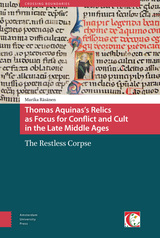
Thomas Aquinas's Relics as Focus for Conflict and Cult in the Late Middle Ages
The Restless Corpse
Marika Räsänen
Amsterdam University Press, 2017
This book offers a new way of looking at Saint Thomas Aquinas-not as a living man, but as a posthumous source of relics. Marika Räsänen delves deep into the strange relationship between Aquinas's physical remains and the devotional moments they enabled-in many cases in situations where the actual relics were not present, but were recreated verbally, pictorially, or allegorically. Both the actual relics and these extended manifestations of them, Räsänen shows, were equally real to the medieval spectator, though the question of the material presence of Aquinas's remains became increasingly important over time amid the political tumult of southern Italy.
[more]
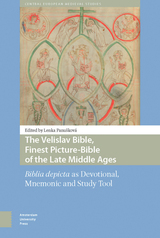
The Velislav Bible, Finest Picture-Bible of the Late Middle Ages
Biblia depicta as Devotional, Mnemonic and Study Tool
Edited by Lenka Panušková
Amsterdam University Press, 2018
The Velislav Bible is one of the most beautiful medieval Bohemian manuscripts. It is a heavily illustrated manuscript that contains only short selections of the text, that instruct the reader about the story depicted. The last picture in the manuscript shows a man kneeling before St. Catherine, identified as Velislav, hence the name of the manuscript. The Bible comprises stories from the Books of Genesis and Exodus, visions of Daniel, and the stories of Samson as well as of Judith. The narrative of the Antichrist precedes the Christological part. The New Testament continues with the Book of Revelation, stories following the Ascension of Christ, and key events from the lives of St. Peter and St. Paul. The manuscript closes with the legend of St. Wenceslas, the patron saint of Bohemia. The essays in The Velislav Bible, Finest Picture-Bible of the Late Middle Ages: Biblia depicta as Devotional, Mnemonic and Study Tool analyze the manuscript from historical, textual, art-historical, and iconographic perspectives. However, a shared concern of all the authors is to think about its functions. An edition of the Latin titulis is being published here for the first time.
[more]
READERS
Browse our collection.
PUBLISHERS
See BiblioVault's publisher services.
STUDENT SERVICES
Files for college accessibility offices.
UChicago Accessibility Resources
home | accessibility | search | about | contact us
BiblioVault ® 2001 - 2024
The University of Chicago Press









